The light spectrum for plants, or the “photosynthetically active radiation (PAR) spectrum,” refers to the electromagnetic wavelength of light that plants require for optimal development.
The light spectrum for plants plays a significant role in the plant’s photosynthesis, yield, growth, and nutritional value. The LED light absorbed by the plants at different wavelengths can drive the photosynthesis levels and further support plant growth.
LED grow lights offer a range of light wavelengths, including red, blue, green, UV, and IR, to enhance plant growth and photosynthesis. LEDs can emit specific wavelengths of light, such as blue (400-500 nm) for seedling growth, a combination of blue and red (600-700 nm) for vegetative growth, primarily red (620-700 nm) for flowering, and a mix of blue and red for fruit, making them ideal for providing customized lighting during different stages of plant growth.
Customizing these wavelengths at different stages of plant development allows growers to optimize biomass growth and trigger specific functionalities for optimal results.
The spectrum chart depicts the wavelengths of light emitted by the LED grow lights and helps us comprehend their impact on plants. Customizing the light spectrum is crucial for optimal plant growth. LEDs offer different types of light spectra, including full spectrum, board spectrum, and targeted spectrum, each playing a specific role in supporting different stages of plant development.
LED grow lights can be categorized into full, broad, and targeted spectrums, providing specific light wavelengths for photosynthesis and influencing plant growth and production, with the choice of lights depending on the grower’s energy efficiency preferences, customization options, and the plants’ specific needs.
Different stages of plant growth require specific light spectrums, with blue light (400-500 nm) being ideal for the seedling stage and a mix of blue and red light (600-700 nm) for the vegetative stage.
The flowering stage benefits from the primarily red light and a combination of blue and red light is used during the fruiting stage. Customized lighting is important for certain plants, such as cannabis, to control THC levels, as they respond differently to wavelengths outside of the PAR spectrum. Cannabis plants require red light from 620-700 nm during the flowering stage to promote bud development and achieve higher yields. In contrast, specific wavelengths of blue and UV-A light can positively impact THC synthesis.
Table of Contents
What is the color spectrum of light?
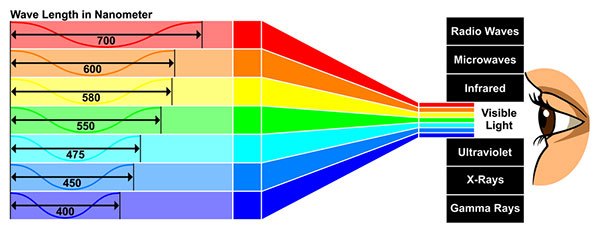
The color light spectrum represents the complete spectrum of electromagnetic radiation, which includes a continuous sequence of wavelengths and corresponding frequencies. The light color spectrum stretches from gamma rays, which have the shortest wavelengths (violet light) and highest energies, to radio waves (red light), which have the longest and lowest wavelengths.
Each light color spectrum is tied to a specific wavelength, while the visible spectrum light to the human eye ranges between 380-750 nm.
The ideal light spectrum for indoor cultivation in environments like grow tents or rooms varies depending on the growth phase of the plants and desired results.
A well-balanced mix of red (600-700 nm) and blue light (400-500 nm) is one of the best light spectra for indoor growing.
In addition to the red and blue light, adding green light (500-600 nm) and small amounts of UV and far-red light (700-800 nm) can provide extra advantages. Green light can penetrate deeper into the plant canopy, impacting overall growth. Controlled exposure to UV light may trigger stress responses and enhance the production of secondary metabolites, while far-red light can influence flowering and photoperiodic responses.
What is the visible light spectrum?
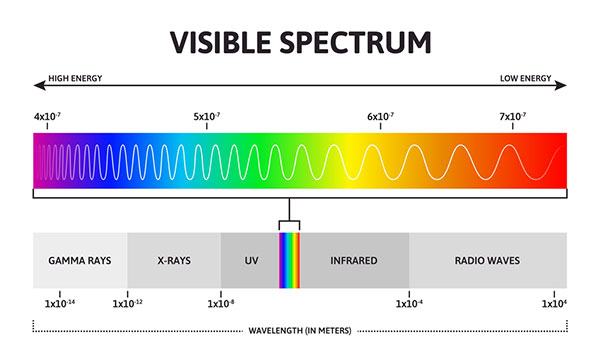
The visible light spectrum refers to the portion of the electromagnetic spectrum that our eyes can detect and perceive as colors. The visible light spectrum ranges from approximately 380 nm to 750 nm in wavelength.
In the visible light spectrum, we can perceive different colors, each with its own range of wavelengths. These colors, listed in order of increasing wavelength, are violet, blue, green, yellow, orange, and red. When white light is passed through a prism or another medium, it separates into these distinct colors because each wavelength bends differently, a phenomenon known as refraction.
Photosynthesis and growth depend on visible light, but plants interact with light in other ways. Plants can absorb and use light beyond the visible spectrum. UV radiation, with wavelengths less than 400 nm, can increase defensive chemical synthesis, while infrared (IR) light, which is longer than 700 nm, creates heat and can indirectly promote plant growth. Due to the longer wavelengths than the visible light spectrum, ultraviolet and infrared lights are invisible to human eyes.
What is the color temperature?
Color temperature is a metric that describes how light appears to our eyes. It is classified as either warm (lower K) or cool (higher K). The measurement is based on the color produced by an object when it is heated to a specific temperature.
Low (warm), neutral, and high (cool) color temperatures describe how light looks to the human eye. Low color temperature, about 2,700K, offers a warm, pleasant yellowish or orange tone, while neutral 4,000k light is balanced and neutral. Light over 5,000K is cold and resembles blueish-white light.
The color temperature of light plays a significant role in the growth and development of plants. Lower color temperatures, such as around 2,700 Kelvin, benefit plants during the flowering and fruiting stages of growth, while higher temperatures of 5,000 Kelvin are recommended for vegetative states.
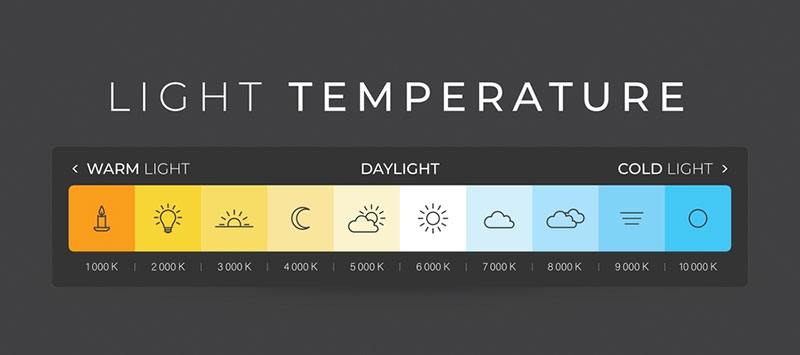
What is light intensity?
Light intensity measures the amount of light energy that reaches a particular area over a specific period. It can be measured using units like footcandles or lux (lx) or photosynthetic photon flux density (PPFD).
Lux measures the brightness or illuminance on a surface, while PPFD calculates the number of photons relevant for photosynthesis and reaches a surface used for plant growth.
The relationship between light intensity and the light spectrum is vital for the growth and development of plants. Light intensity tells us how much light there is, while light spectrum refers to the characteristics of the light, such as the different wavelengths it contains.
How does the visible light spectrum relate to photosynthesis?
The visible light spectrum plays a vital role in plant photosynthesis. Leaves capture light energy to give their enzymes the necessary energy for photosynthesis. Photosynthesis is a biological mechanism where plants utilize light energy to convert carbon dioxide and water into glucose (sugar) and oxygen. The visible light spectrum provides the energy necessary for photosynthesis to occur.
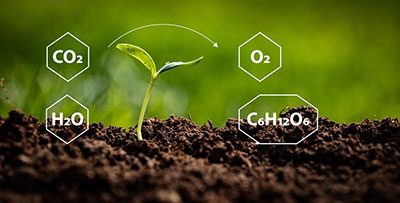
Chlorophyll, the main pigment in plants that absorbs light energy, is highly effective at absorbing specific wavelengths within the visible light spectrum, specifically blue (400-500 nm) and red light (600-700 nm).
The absorbed photons energize the electrons in the chlorophyll molecules, further forming glucose.
The two main types of pigments involved in photosynthesis are chlorophyll and carotenoids.
Chlorophylls are the primary pigments that absorb light energy and initiate the photosynthetic process. There are several chlorophyll types, the most common ones being chlorophyll-a and chlorophyll-b.
Chlorophyll-a absorbs light in the blue and red regions of the spectrum, while chlorophyll-b is found in higher plants, algae, and certain bacteria. It absorbs light in the blue and red-orange hues of the spectrum and transfers the absorbed energy to chlorophyll-a.
Cartenoids are pigments located within the thylakoid membranes of chloroplasts alongside chlorophyll molecules, allowing them to work together with chlorophyll by capturing additional light energy and protecting it from further damage.
Cartenoids absorb light in different spectrum regions, including blue and green light, and provide plants with shades of yellow, orange, and red.
Chlorophylls and carotenoids work together in order to broaden the spectrum of light wavelengths captured, transfer energy to chlorophyll-a molecules and optimize the conversion of light energy into chemical energy.
The bond between chlorophyll and carotenoids enhances the plant’s photosynthesis capabilities and protects it from excessively damaging light.
Chlorophyll absorbs the majority of red and blue regions of the visible electromagnetic spectrum. Wavelengths of 400-500 nm and 600-700 nm, found in red and blue lights, contribute the most energy for photosynthesis.
Red light is critical for promoting photosynthesis, flowering, and fruiting, while blue light affects plant growth and development.
On the contrary, yellow-green light is less effective at driving photosynthesis due to its lower absorption by chlorophyll.
In controlled amounts, the UV light spectrum can also contribute to building the plant’s effective mechanism, while the far-red light (700-800 nm) influences the flowering stage of the plant.
How does the light spectrum affect plant growth?
To support the growth of plants and optimize their development, it is important to understand that each light spectrum influences plant physiology differently, as different wavelengths play specific roles in the process.
Plants primarily absorb light in the range of approximately 400 to 700 nanometers (nm), corresponding to the visible light spectrum. This range is known as the photosynthetically active radiation (PAR) range and includes various light colors, such as blue, green, yellow, orange, and red.

Blue Light
Blue light, with a wavelength range of approximately 400 to 500 nm, plays a crucial role in regulating physiological processes in plants. It impacts plant growth by influencing chlorophyll production, stomatal openings, and vegetative growth.
Blue light can accelerate the flowering process in plants, according to the Department of Environmental Horticulture’s research on “Impact of Blue Light on Plant Growth.” Blue light is essential for chlorophyll synthesis and promotes photosynthesis, allowing plants to absorb more carbon dioxide.
Additionally, blue light helps develop strong stems, dense foliage, and healthy root systems during the vegetative phase. Cryptochromes and phototropins, pigments in plants, act as photoreceptors, sensing and responding to blue light to activate various growth-related pathways.
Green Light
Green light, falling within the wavelength range of approximately 500 to 600 nanometers (nm), has medium wavelengths and moderate energy.
Green light spectrum is the color that is most reflected by chlorophyll, which is why plants appear green. The green light spectrum impacts plant biomass and even reverses the effects of UV-B and blue light.
Additionally, green light has been found to drive photosynthesis in chloroplasts towards the bottom surface of leaves.
Even though green light is absorbed to a lesser extent, other pigments like carotenoids can still capture it. These pigments assist in transferring energy to chlorophyll molecules for photosynthesis.
Moreover, recent studies published in the National Library of Medicine on “Green light signaling and adaptive response” suggest that green light can activate specific signaling pathways, influencing various plant responses and physiological processes.
Yellow Light
Yellow light spectrum ranges from 570 to 590 nanometers (nm). Within the visible spectrum, yellow light sits between green and orange, with longer wavelengths than green but shorter than orange.
Yellow light possesses moderate energy and is not absorbed as much as other colors by chlorophyll.
Like green light, chlorophyll does not absorb yellow light as efficiently as blue and red light. Consequently, it has restricted direct impacts on plant growth and development. Yellow light might influence photoperiodic responses, which involve plants sensing the length of the day to initiate flowering or other developmental changes.
However, according to the study in “Journal of Photochemistry and Photobiology B: Biology”, when compared to red or blue light treatment, the use of yellow light had positive effects on factors such as shoot number, dry biomass per plant, and net photosynthesis rate (Pn).
Orange Light
Orange light is typically found in the wavelength range of around 590 to 620 nanometers (nm). It sits within the visible spectrum, with longer wavelengths than yellow but shorter than red light. Like yellow, orange light has moderate energy and is absorbed by plant pigments to different degrees.
Orange light can affect multiple aspects of photomorphogenesis, which includes influencing growth patterns, leaf expansion, and other developmental processes in plants.
Certain photoreceptor pigments like phytochromes can absorb orange light, potentially initiating signaling pathways that contribute to plants’ photomorphogenesis and other physiological responses.
Red Light
Red light, ranging from 600 to 700 nm, is an important factor in plant growth and development. It plays a role in photosynthesis, fruit production, and stem elongation. Photosynthesis relies on 600-700 nm red light for ATP and NADPH production. Red light also stimulates phytochrome photoreceptors, triggering flowering and fruit development.
Additionally, red light affects stem elongation, although combining it with a small amount of blue light can inhibit elongation. Red light interacts with phytochromes, leading to changes in gene expression and activating plant signaling pathways. This molecular switch has significant effects on plant physiology.
Do indoor plants need ultraviolet (UV) light?
No, indoor plants do not necessarily need ultraviolet (UV) light for their growth and development.
Ultraviolet (UV) radiation is a type of electromagnetic wave with a shorter wavelength than visible light. The UV light spectrum is categorized into three main types: UV-A (315-400 nm), UV-B (280-315 nm), and UV-C (100-280 nm).
Plants can be negatively impacted by excessive exposure to ultraviolet (UV) light, particularly UV-B (280-315 nm). At the same time, small and controlled amounts of UV radiation can promote positive responses in plants and enhance the production of certain secondary metabolites, such as flavonoids.
Intense UV exposure damages DNA causes mutations, and reduces photosynthesis in plants. To prevent harm, plants activate antioxidants and repair enzymes. However, continuous UV radiation exposure can override these defense systems, causing long-term damage, restricted growth, and poor plant health.
While many houseplants can thrive without direct exposure to UV light, some species rely more on it. Green plants native to high-altitude regions or those that naturally grow in areas with ample sunlight, like succulents, cacti, and some tropical plants, often benefit from moderate levels of UV light.
Do indoor plants need infrared light (IR)?
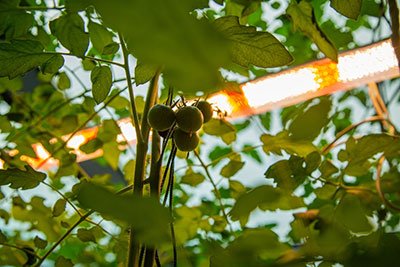
Indoor plants can benefit from infrared (IR) light, although it is not considered essential for their growth. Infrared (IR) light, particularly near-infrared (NIR) light, is a form of electromagnetic radiation characterized by longer wavelengths than visible light.
IR light primarily affects plant physiology by increasing leaf temperature and promoting overall plant growth. While excessive exposure to IR light can lead to heat stress and damage, a moderate amount of IR radiation can positively affect certain stages of plant development.
The effect of IR light on plants varies depending on the specific growth stage. For instance, increased exposure to far-infrared light has been observed to promote stem growth and increase the spacing between stems. Additionally, plants exposed to IR light may exhibit larger leaves, a response aimed at capturing more light for photosynthesis.
Certain types of plants, like tomatoes, cannabis, peppers, or even specific growth stages, may benefit more from IR light. For example, plants in the flowering stage can benefit from the addition of IR light, as it has been reported to stimulate flowering and enhance the production of flowers.
While IR light can enhance plant growth, it should be noted that visible light, specifically red and blue wavelengths, remains the most crucial for photosynthesis. Therefore, providing a balanced combination of visible and IR light is recommended for optimal indoor plant cultivation.
What is the ideal spectrum light for growing plants?
Each stage of a plant’s growth cycle, as seedling, vegetative, flowering, or fruiting stages, requires a different spectrum of light for optimal growth and development.
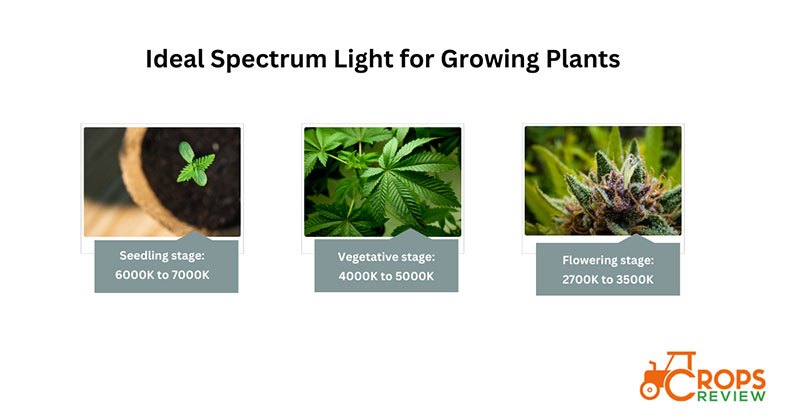
Seedling stage: During the seedling stage, plants require a high amount of blue light (400-500 nm), which creates strong roots and sturdy growth.
A color temperature around 6000K to 7000K, representing cooler, bluish light, aligns well with the blue light emphasis needed for seeding growth.
Vegetative stage: The vegetative stage of the plant requires a broad spectrum of both red and blue light for both stem growth and branching. A color temperature of around 4000K to 5000K provides a balanced blend of warm and cool tones, matching the blue and red light requirements for vegetative growth.
Flowering stage: In the flowering and fruiting stages, plants will benefit most from red light (600-700 nm), as the light promotes bud flowering and the plant’s ripening. A color temperature around 2700K to 3500K is best for flowering and fruiting.
Using a different light spectrum for different plants is beneficial as every plant has different requirements based on its growth stage and growing environment.
It is ideal to adjust each light intensity per the plant stage and keep track of its progress. Different light spectrums are used for different plants, including cannabis, due to unique photosynthetic needs and responses to specific light wavelengths.
What’s the ideal grow light spectrum for cannabis?
The ideal grow light spectrum for cannabis is blue, red, and far-red light.
The ideal spectrum, due to growth stage customization, is meant to boost cannabis output and THC content, which is why its adjustment is different from other plants.
THC control isn’t a consideration for most other plants, making cannabis spectrum adjustments highly specific to its desired chemical profile.
Blue and red light boost flower yields. THC synthesis can be affected by light spectrum manipulation. For constant development, the cannabis canopy needs even light dispersion.
Balancing far-red and blue light is important to achieve desired plant responses. Depending on growth goals, adjusting the ratio of these wavelengths can influence aspects like flowering, stem elongation, and overall plant architecture.
What is the spectrum of LED grow lights?
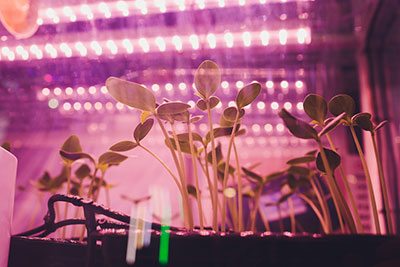
The spectrum of LED grow lights can differ based on the particular product and its intended application. LED grow lights are designed to emit light energy across the complete range of visible wavelengths, including blue, red, green, yellow, and occasionally ultraviolet (UV) wavelengths.
The ability to customize the spectrum of LED grow lights has significantly impacted plant growth and development. By providing light conditions that are carefully tailored to match the unique needs of different plant species and growth stages, growers can exert precise control over various physiological and developmental processes. This level of customization ultimately results in healthier plants, faster growth rates, and increased fruit yield.
Compared to traditional HPS lamps for indoor and greenhouse lighting farming, LED grow lights use less energy, emit less heat and targeted light, and can provide specific light wavelengths for optimal growth.
LED lights are an ideal choice for scaling crop production because they are efficient, versatile, and adaptable to different cultivation environments. The qualities in question refer to energy efficiency, compact design, reduced light pollution, and customization.
Furthermore, evaluating the energy output of LED grow lights entails considering factors such as the intensity and spectrum of light provided, which should align with the specific needs of the plants under cultivation.
Do LED light spectra affect indoor plants’ growth, yield, and nutritional value?
Yes, the spectrum of LED lights plays a crucial role in shaping indoor plants’ growth, yield, and nutritional composition. The unique combination of certain wavelengths and proportions of light within the proper spectrum can influence a wide range of physiological processes within plants, ultimately impacting their overall development and qualities.
A study titled “Comparison of Growth, Development, and Photosynthesis of Petunia Grown Under White or Red-Blue LED Lights” examined how various LED spectra affect the growth of petunias.
The findings revealed that using a combination of red and blue LEDs resulted in greater shoot and root biomass growth, enhanced leaf growth, and overall improved growth compared to other spectra, proving that significant LED spectra can influence plant morphology and growth characteristics.
What is the ideal LED grow light spectrum for indoor plants?
The ideal LED grow light spectrum for indoor plants includes a balanced combination of red, blue, green, and yellow light, closely mimicking natural light to promote photosynthesis, vegetative growth, flowering, and overall plant health. These colors can be sub-categories under full spectrum, broad spectrum, or targeted spectrum lights.
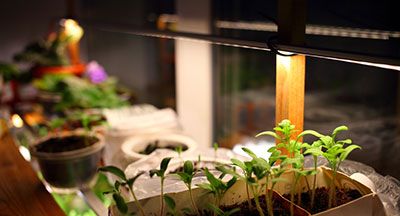
Full Spectrum Light: Full spectrum light emits light across the entire visible spectrum, mimicking natural light and supporting plant growth at all stages. Full spectrum lights are achieved by combining different LED lighting that emits diverse wavelengths across the electromagnetic spectrum, including visible light, UV, and IR. To choose the right full spectrum lights, consider the light needs of your plant species and your growth stage.
Broad Spectrum: Broad spectrum LED grow lights cover a significant range of wavelengths, resembling sunlight’s diversity. Broad spectrum LED grow lights promote holistic plant development, nutrient absorption, and overall health and consist of multiple LEDs emitting various wavelengths across the electromagnetic spectrum. By simulating natural sunlight, the broad light LED spectrum enhances the growth of healthy stems, flowering, and photosynthesis in plants.
Targeted Spectrum: Targeted spectrum LED grow lights focus on specific wavelengths crucial for different plant stages. They optimize growth by tailoring light to precise needs, enhancing efficiency. One of the key benefits of targeted spectrum LED grow lights is that they maximize efficiency and energy use while promoting healthy growth. The only limitation of the targeted spectrum LED grow lights is that they miss out on broader plant responses due to focusing solely on targeted wavelengths.
What are LED grow light spectrum charts?

LED light spectrum charts represent the distribution of light wavelengths emitted by a particular LED grow light fixture.
Growers may determine if the light source supplies the wavelengths needed for photosynthesis, blooming, and plant health by checking the spectrum chart and choosing a light source that suits their plant type and growth stage.
How to read LED grow light spectrum charts?
The interpretation of spectrum charts involves analyzing 3 different components:
X-Axis (Wavelength): The X-axis demonstrates the wavelengths in nanometers (nm), ranging from shorter wavelengths like blue on the left side to longer wavelengths like red on the right side.
Y-Axis (Light Intensity): The Y-axis represents the light intensity, indicating the amount of light emitted at each specific wavelength.
The spectrum is represented through a line graph, where different colors signify various parts of the spectrum, such as blue, green, and red. The height of the line at each wavelength reflects the intensity of light emitted at that particular point on the spectrum.
Peaks indicate the LED grow light’s most powerful wavelengths. These wavelengths are essential for plant functions, including chlorophyll absorption during photosynthesis, while valleys have decreased light intensity, which may hinder plant development.
It’s important to note that plants respond differently to each light spectrum. Growers must consider plant demands while evaluating spectrum charts. The wavelengths needed by a few plants that flourish in full-spectrum sunlight may differ from those that thrive in shady settings.
The red-to-blue light ratio is crucial for plant responses. Flowering and fruiting benefit from a stronger red-to-blue ratio, whereas vegetative development benefits from a balanced ratio. Spectrum ratio affects plant morphology and blooming.
How to choose the best LED grow lights?
When choosing the best LED grow light, these are the top 5 factors you need to consider:
- Calculate the wattage per square foot: Aiming for 20 to 40 watts per square foot of growing space is a good rule of thumb. This will ensure sufficient light intensity for your plants to thrive in different growth stages.
- Look for full-spectrum lights: Full-spectrum LED lights provide a wide range of light wavelengths that mimic natural sunlight. This helps promote healthy plant growth and development.
- Consider the CRI rating: Choose LED grow lights with a high Color Rendering Index (CRI) rating. A CRI rating above 85 is recommended, but the closer to 100, the better. This ensures accurate color representation for your plants.
- Check the light wavelengths and spectrum: Different plants have specific light wavelength requirements for optimal growth. Ensure the LED grow lights offer the right wavelengths and spectrum for your plants’ needs.
- Look for high efficacy: Efficacy refers to the amount of light produced per watt of energy consumed. Choose LED grow lights with high efficacy (µmol/J) to ensure efficient energy usage and effective plant growth.

HELLO friend! Nice topic. you have study spectrum with other type of plants? horticulture for example, soil, rice…
have a good day